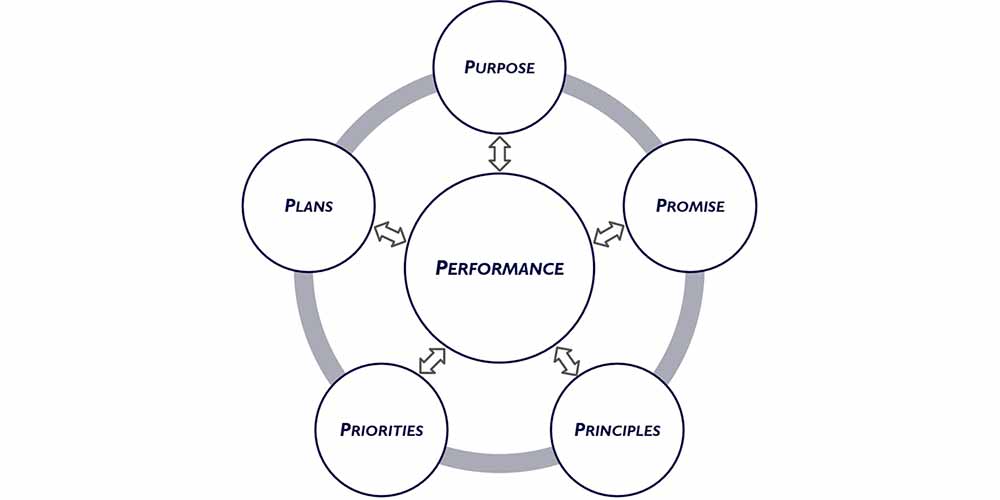How to get project success with UGM’s 6Ps of strategy planning
The power of a clear direction statement
UGM developed the ‘6Ps of Strategy Planning’ to help our clients discuss and communicate elements of their strategy. In particular, we’ve helped senior teams in a wide range of organisations and sectors work together to create powerful strategies that will take their organisations into the future. Our ‘6Ps of Strategy Planning’ framework has proved particularly useful, and we’d like to share it with you here.
Research repeatedly demonstrates the value of a clear and well communicated statement of direction. It also shows that, with few exceptions, the risk of under-performance and failure increases when direction is unclear. Yet, it is surprising how often organisations and their operating units don’t have, or don’t publicise (even internally), this type of statement. The 6Ps of Strategy Planning makes this task a lot easier to achieve.
Purpose
Instead of using the much debated (and often maligned) terms Mission and Vision, we chose the term Purpose. Why are we here? Why do we exist? People get it instantly! There’s no need for a lengthy definition. It’s a very easy concept to grasp. Once you’re clear on your Purpose (and that’s worth debating and revisiting from time to time), it becomes the ultimate test of everything you do.
Promise
Because your Purpose is succinct and to the point, you’ll want to articulate what you’ll be doing to achieve it. The Promise captures this detail. What high-level promises are you making?
You’ll be making a number of promises to your customers/clients. It’s helpful to flesh these out in a Customer Value Proposition (CVP).
You’ll also be making promises to your people, and an Employee Value Proposition (EVP) is a useful way of developing this detail.
Finally, there will be promises you make to your stakeholders, and a Shareholder / Stakeholder Value Proposition (SVP) will provide additional clarity.
Your community is one of your stakeholders, so this is where you’d make any commitments around being a good organisational citizen.
Principles
Many organisations develop a list of Values, but far fewer actually see them lived out consistently, in all reaches of the organisation. A key reason is the confusion that arises over what a Value really is (and what it isn’t). We use the term Principle instead. Again, we’ve noticed instant connection with the term. It needs little explanation. You can include a Value, such as collaboration, as a Principle statement. And, it’s equally easy to include Principles like, ‘do only profitable work’, or ‘cause zero harm’ (instead of ‘Safety’) which do not fit the Values criteria.
Priorities
We offer you another breakthrough here. Goals and Objectives give direction, but they don’t inform about relative importance. Priorities are our Goals/Objectives, but we’ve ranked them. UGM has found many instances where people don’t know how best to allocate their efforts. Priorities provide that crystal clarity. You can use these to prioritise the contribution of every individual in your organisation. With clear Priorities, it’s much easier for people to continually choose activities that will add the most value (highest priority).
Plans
The penultimate ‘P’ is Plans. Developing high level implementation plans at the time of strategy development helps overcome the biggest cause of strategy failure – poor implementation! By ensuring a set of plans is in place (along with metrics), your strategy has a much better chance of success than if left to chance, after-the-fact.
The ability to develop viable implementation Plans is an effective ‘stress test’ of the strategy. It helps ensure the strategy team remains grounded. If the assembled ‘strategy team’ is unable to develop those high level plans because others need to be involved then the strategy team is probably incomplete.
Performance
Performance is the end goal of a strategy! It’s intentionally at the core of the 6Ps framework. Clear metrics and regular measurement help you know how you’re tracking, and what success will look like. Importantly, successful outcomes result from a well-aligned plan.
If you’re not already working with a clear statement of direction, we strongly encourage you to develop one as a priority. If you already have one, we invite you to test it against our 6Ps framework. It will help identify areas where you can add the strength and clarity that support improved Performance.
PRACTICAL IDEAS TO APPLY IN YOUR BUSINESS
Tips to develop the 6 Ps of strategy planning
- Purpose: This is often the toughest to define, but is potentially very powerful, so worth the effort. In one sentence, ‘Why do we exist’? What high level statement describes what we do? For example, “Providing affordable health care”, or “Helping organisations realise the value of their people”.
- Promise: This element gives our Purpose some substance. What are the few big ticket promises we’ll commit to? We’ll probably have one or two in a number of categories. For example, ‘We promise our clients best value. We promise our people a stimulating workplace.’
- Principles: What principles will we truly live in our organisation? For example, ‘We keep our Promises”.
- Priorities: What are our priorities? If we imagined having to scale back, what is the order in which we’d cut offerings? How well does this ranking match our perception of what creates value in the organisation? How well do our Priorities match our Purpose?
- Plans: Do we have clearly stated outcomes? What does success look like? How will we measure performance? What will monitoring look like? What do we need to enable Performance?
- Performance: The clarity provided by each element above will make it crystal clear what needs to be done to deliver!



